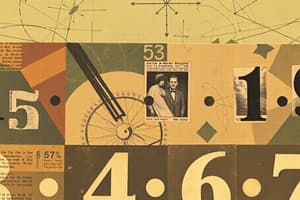Podcast
Questions and Answers
What does the numerator represent in a fraction?
What does the numerator represent in a fraction?
- The horizontal line dividing the numerator from the denominator
- The total number of equal parts making up the whole
- The bottom number in a fraction
- The number of parts being considered as a whole (correct)
Which term refers to the bottom number in a fraction?
Which term refers to the bottom number in a fraction?
- Denominator (correct)
- Fraction bar
- Vinculum
- Numerator
In \rac{3}{4}\rac{3}{4}, what does the 4 represent?
In \rac{3}{4}\rac{3}{4}, what does the 4 represent?
- The numerator
- An imaginary number
- The total number of equal parts making up the whole (correct)
- A decimal number
How can fractions with the same denominator be manipulated?
How can fractions with the same denominator be manipulated?
What is the term for the horizontal line dividing the numerator from the denominator in a fraction?
What is the term for the horizontal line dividing the numerator from the denominator in a fraction?
Which number can the numerator typically be in a fraction?
Which number can the numerator typically be in a fraction?
What is the result of multiplying \(rac{3}{4}\) by its opposite?
What is the result of multiplying \(rac{3}{4}\) by its opposite?
Which two fractions are equivalent?
Which two fractions are equivalent?
What is the negative of \(-\frac{2}{3}\)?
What is the negative of \(-\frac{2}{3}\)?
Which fraction is the result of reducing \(rac{20}{30}\) to its simplest form?
Which fraction is the result of reducing \(rac{20}{30}\) to its simplest form?
What is the product of \(3\frac{1}{2}) and \(\frac{7}{8})?
What is the product of \(3\frac{1}{2}) and \(\frac{7}{8})?
Which of these numbers is considered a mixed number?
Which of these numbers is considered a mixed number?
Flashcards are hidden until you start studying
Study Notes
Fractions: Understanding Basic Arithmetic and Number Concepts
Fractions are a fundamental part of mathematics that allow us to represent and work with parts of a whole. In this article, we'll delve into the basic arithmetic and number concepts related to fractions, as well as cover some essential operations and opposite numbers in fractional form.
Basic Fraction Terminology
Before we delve into the mechanics of fractions, let's cover a few key terms:
-
Numerator: The top number in a fraction represents the number of parts being considered as a whole.
-
Denominator: The bottom number in a fraction represents the total number of equal parts making up the whole.
-
Fraction bar: Also known as the vinculum, the horizontal line dividing the numerator from the denominator is simply a convenient way to separate the two numbers in a fraction.
Fractional Numbers
Fractions are often represented as one number (the numerator) over another (the denominator), such as (\frac{3}{4}) or (\frac{7}{10}). The denominator of a fraction can be any whole number greater than zero, while the numerator is typically a whole number or a decimal.
Fraction Operations
Fractions can be manipulated using basic operations like addition, subtraction, multiplication, and division.
-
Addition and Subtraction: Fractions with the same denominator can be added or subtracted by combining or subtracting their numerators. If the denominators are different, they must first be converted to a common denominator before performing the operation.
-
Multiplication and Division: Multiplying two fractions involves multiplying the numerators and the denominators separately. For division, we can rewrite the division as a multiplication by inverting the second fraction.
Opposite Numbers
In mathematics, the opposite of a fraction is known as its negative, or additive inverse. The negative of a fraction is found by changing the sign of the numerator while keeping the denominator the same.
- For example, the negative of (\frac{5}{6}) is (-\frac{5}{6}).
Important Concepts
-
Equivalent Fractions: Equivalent fractions are different fractions that represent the same part of a whole. For example, (\frac{1}{2}) and (\frac{2}{4}) are equivalent fractions, as they both represent half of a whole.
-
Reducing Fractions: Reducing a fraction means simplifying it by finding the highest common factor (HCF) of the numerator and the denominator and dividing both by it. For example, (\frac{12}{18}) can be reduced to (\frac{1}{3}) by finding their HCF (which is 6) and dividing both the numerator and the denominator by 6.
-
Mixed Numbers: Mixed numbers include both whole numbers and fractions. For example, (2\frac{1}{2}) is a mixed number, where the whole number is 2 and the fraction is (\frac{1}{2}).
As you continue to practice and learn about fractions, you'll begin to see how these fundamental parts of mathematics can be applied to various real-world situations in science, engineering, and daily life.
Studying That Suits You
Use AI to generate personalized quizzes and flashcards to suit your learning preferences.



